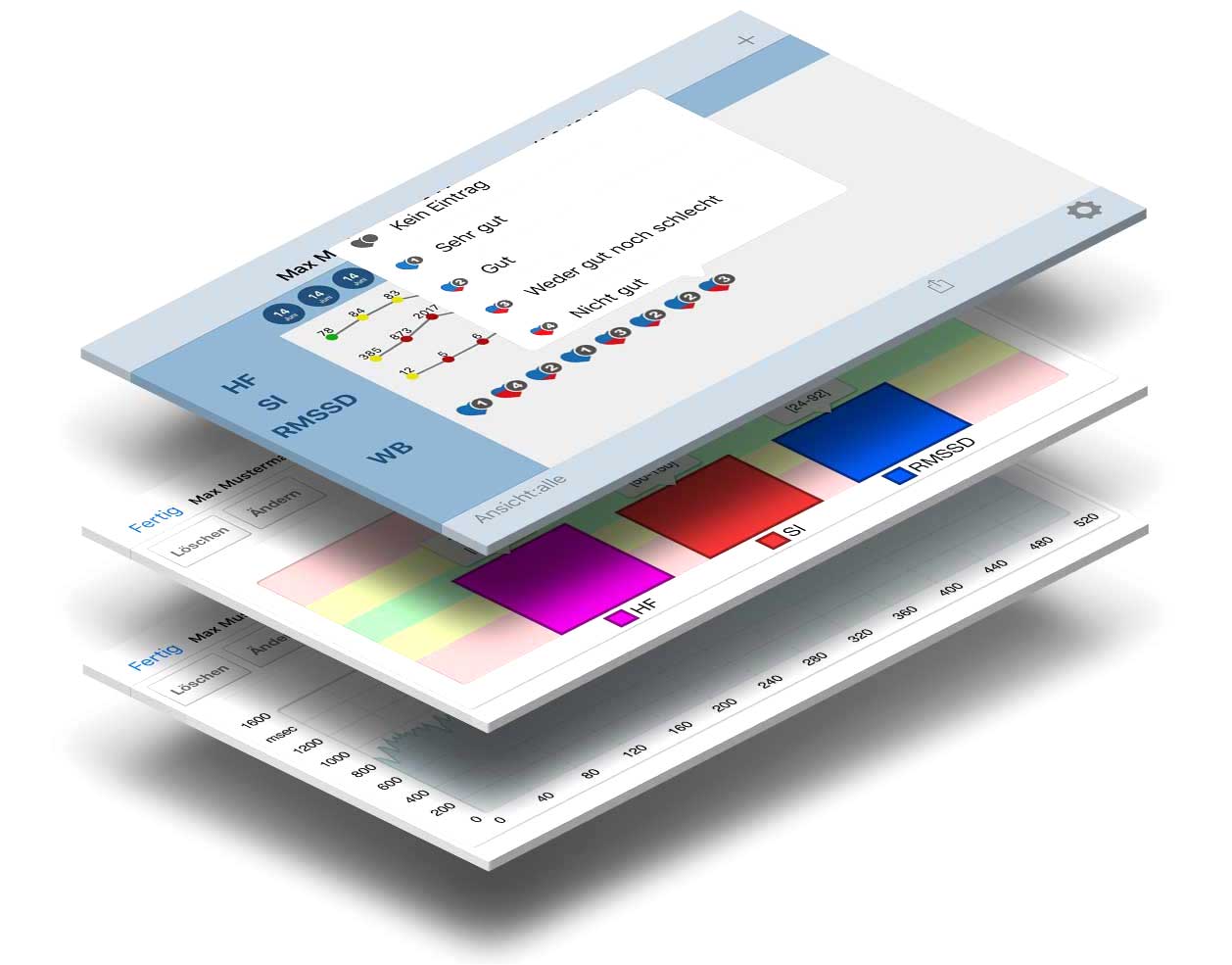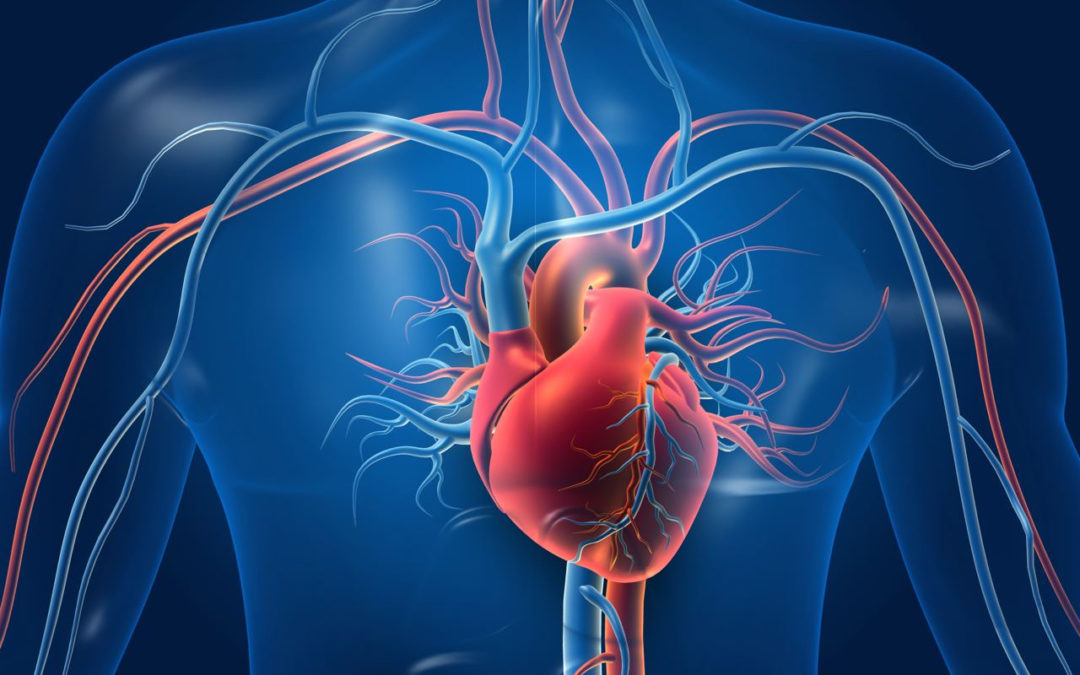Heart rate variability (HRV): What is it and why should we know more about it?
HRV Analysis measures the time intervals from heartbeat to heartbeat (RR intervals) in milliseconds. An ECG records the so-called QRS complex, whereby in a resting measurement the time intervals vary constantly and should be different.
The heart is controlled by the superordinate autonomic nervous system (ANS) with sympathetic and parasympathetic nervous system via the impulse conduction system. Since internal and external stimuli are generally registered and processed by the sympathetic and parasympathetic nervous systems, sensible reactions (regulation) follow in order to prepare the organism as best as possible for current needs and situations (e.g. acute danger = provision of energy). A permanent stress situation inevitably leads to a changed excitation of the heart. This changes the RR interval, i.e. the heart rate variability.
With an HRV analysis, it is possible to determine how well or poorly the ANS can process, respond to and regulate stimuli at rest. And whether the regulation is very good/good/restricted/very restricted or whether there is regulatory rigidity.

Methodology of the HRV Analysis
HRV analysis measures the distance from heartbeat to heartbeat. The basis of the measurement is the recording of a technically flawless electrocardiogram, in which the intervals between the individual R-spikes can be recorded and processed cleanly and without interference. There are so-called short-term measurements of 5 to 10 minutes and long-term measurements that are recorded over 24 hours. The scientific standards for HRV measurement and evaluation were precisely defined by a commission of experts in 1996 and are today the basis for HRV analysis being included as a basic diagnostic in the evidence-based national health care guidelines. The sequence of intervals can be analysed using various mathematical-statistical methods.
A distinction is made here between:
- Time-domain parameters
- Frequence-domain parameters
- Non linear parameters, e.g. DFA – alpha1

HRV Analysis: evidence-based diagnostics
- Since July 2011, HRV/VNS analysis has been part of the curriculum “Special Pain Therapy” at the Hannover Medical School
- Since August 2011, it has been included in the evidence-based national health care guidelines as a basic diagnostic and as a more advanced diagnostic
- Included in the guidelines of the German Diabetes Society
- Included in the guidelines of the German Society for Occupational and Environmental Medicine (DGAUM)
- Recommendation of the Professional Association of German Internists (BDI) of 19.08.2010
- Billing recommendation of the German Medical Association and the BDI (GOÄ 652)
- More than 17,000 studies worldwide currently prove the benefit of VNS/HRV diagnostics for a wide range of specialities and indications
Further milestones of HRV-Analysis
- 1891: Müller shows a smaller increase in HF to atropine in heart patients
- 1927: Winterberg and Wenkelbach describe respiratory sinus arrhythmia
- 1965: Hon and Lee describe changes in RR intervals in “fetal distress”
- 1972: Hinkel et al. show increased risk of cardiac death with reduced respiratory sinus arrhythmia
- 1978: Wolf et al. describe relationship between HRV and infarct mortality
- 1981: Akselrod et al.: “Spectral analysis of HRV is significant as a non-invasive, quantitative measure of the functionality of cardiovascular control circuits”
- 1990: HRV analysis is introduced into clinical cardiology and diabetology
- 2000: HRV becomes part of the risk stratification for sudden cardiac death
- 2010: HRV analysis is included in the programme for national health care guidelines in the field of neuropathy in adult-onset diabetes
- 2011: HRV analysis is included in the curriculum for special pain medicine and psychosomatics at the MHH
Dr. Johann Diederich Hahn-Godeffroy: „To keep the vegetative, the balance of tension and relaxation, harmoniously in equilibrium means: art of living.“
Scientific basis of heart rate variability HRV
In order to avoid misinterpretation of the various HRV parameters, guidelines were laid down in 1996 for the performance and interpretation of HRV analyses (HRV measurements) by the:
- Task Force of the European Society of Cardiology
- North American Society of Pacing and Electrophysiology Task Force of the European Society of Cardiology and North American Society of Pacing and Electrophysiology: Heart rate variability. Standards of measurement, physiologic interpretation, and clinical use. Circulation 1996; 93:1043-106
Graphical evaluation and display of the main HRV parameters
The basis of the HRV analysis app (available for iOS and Android) is the detection of 520 (or 260 in the case of the short measurement) technically faultless RR intervals by a chest strap with a measurement resolution of 1ms and their subsequent evaluation. The transmission of the data from the chest strap to the receiver is done digitally via radio according to the standardized Bluetooth protocol.
The subsequent graphic display and calculation of the main HRV parameters is done by the software. No data is sent to external servers for calculation. The calculations take place locally on the respective end device (smartphone/iPad). The HRV analysis has been optimized for daily use by normal users/end users.
For doctors and therapists, there is a special professional version from the company Commit GmbH (www.vnsanalyse.de). A time-consuming, subsequent error analysis of the measurement data and manual error correction (as is often the case with wired systems with ECG electrodes) is not necessary because this happens automatically “just in time” during the measurement.
Read more about the graphic evaluation here (coming soon).
In HRV analysis, the three most important parameters heart rate, SI (stress index) and RI (rest index, parasympathetic activity) are calculated and displayed graphically

Measurement parameters for HRV analysis:
- Time-based HRV parameter RR: Distance between two heartbeats (R-points in the QRS complex/EKG)
- NN: Distance between two heartbeats (normal to normal)
- SDNN: Standard deviation of all NN intervals
- SDANN: Standard deviation of the mean of the NN intervals in all five minutes of the whole recording
- SDANN-i: Standard deviation of the mean normal NN interval for all five-minute intervals in a 24-hour recording
- SI: Stress index, reflects sympathetic activity
- RI: Square root of the root-mean-square of the sum of all differences between adjacent NN intervals (higher values indicate increased parasympathetic activity)
- pNN50: Percentage of intervals with at least 50 ms deviation from the preceding interval (higher values indicate increased parasympathetic activity)
- SDSD: Standard deviation of differences between adjacent NN intervals
- NN50: Number of pairs of adjacent NN intervals that deviate from each other by more than 50 ms in the entire recording


